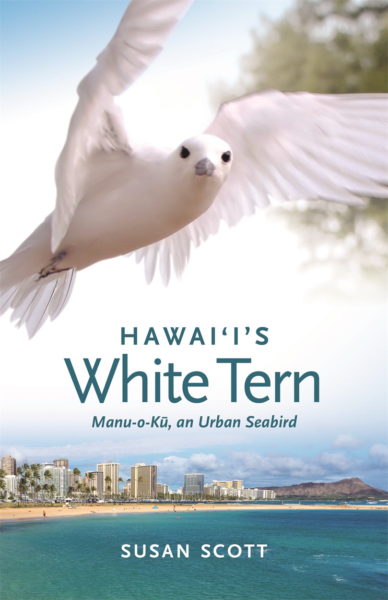Published in the Ocean Watch column, Honolulu Star-Advertiser © Susan Scott
November 30, 2018
The University of Hawaii Press released “Hawaii’s White Terns, Manu-ô-Ku, an Urban Seabird” last week. Most of what we know about our city’s much-loved white terns is in the book, and although my name is on the cover as the author, creating it took a type of teamwork that only Hawaii can produce.
I met my first white terns on Tern Island in the late 1980s when I sailed there to write about the wildlife of Hawaii’s Northwestern Hawaiian Islands. I barely knew what a fairy tern (as they were called then) was when the refuge manager, who was banding chicks, placed one in my hand. Like our kolea, or Pacific golden plover, to hold a white tern is to fall in love forever.
White terns have long been common in the Northwestern Hawaiian Islands, now the Papahanaumokuakea Marine National Monument. No one knows, however, whether these seabirds raised chicks on the main islands before the arrival of ancient Polynesian voyagers or during the time of Hawaiian settlement.
In 1869, Sanford B. Dole noted that white terns were present in the human-inhabited islands but made no mention of parents raising chicks here. That changed in 1961 when an avid birder noted, for the first time on Oahu, an adult sitting on an egg in tree near Koko Head.
Since then the white tern population in Honolulu has gradually increased. Today it’s common to see white terns flitting around the city. In 2016 researchers counted approximately 2,300 of them in Honolulu trees.
The number of white terns is on the rise, but their range has expanded only slightly. Most breed in areas already occupied by other white terns, between Niu Valley and Joint Base Pearl Harbor-Hickam. So far, the only white tern chick found outside that area was a youngster that ended up in Kailua after falling off of a pickup truck.
As the white tern population has increased, so have white tern fans. In writing this book it was my pleasure to work with citizen scientists, researchers, government employees, educators, wildlife groups, writers, photographers, tree trimmers, birders, office workers, condo dwellers and others working to protect Honolulu’s white tern population.
You can help white terns by learning what they need to thrive, sharing information about the species and supporting local seabird groups. I’m donating my royalties from the book to the Hawaii Audubon Society.
Books are available at the UH Press website, the Hawaii Audubon Society store and on Amazon. I will be signing books from 1 to 2 p.m. today at BookEnds in Kailua.
Join me in spreading the word about Honolulu’s remarkable white terns. It takes a hui.
